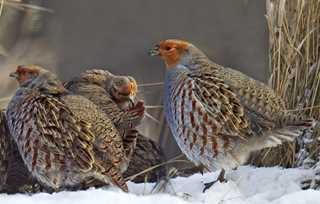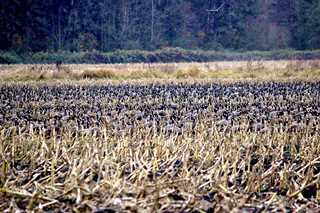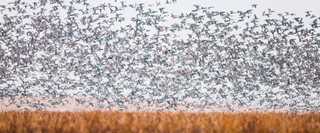Alberta Grand Slam
Follow the author as he hunts divers, dabblers, geese, and Hungarian partridge on the Canadian prairie
Follow the author as he hunts divers, dabblers, geese, and Hungarian partridge on the Canadian prairie

By Matt Young
Pat Kehoe fought the steering wheel as the big four-wheel-drive pickup fishtailed along a muddy back road winding across the Alberta prairie. Soaked by a heavy rain the day before, the typically dusty road surface now had the consistency of axle grease. With a rocky embankment on one side of the road and a deep ditch on the other, there was little margin for error, especially with a 16-foot boat mounted with a Go-Devil motor in tow. Fortunately, the veteran DU Canada biologist has had extensive driving experience on slick prairie roads, and we had little difficulty reaching our destination-a remote irrigation reservoir located miles from the nearest paved road.
The eastern horizon smoldered beneath a sparkling curtain of stars as we launched the boat from a neglected boat ramp on the lakeshore. The Go-Devil rumbled to life, and we set out across the open waters of the reservoir shrouded by a thin layer of fog. Peering through the mist, I caught occasional glimpses of diving ducks taking flight ahead of the boat, their dark forms visible only for an instant before vanishing into the gloom.
Kehoe throttled down the motor when we approached a narrow point of bulrushes extending into a broad, shallow bay. A traditionalist who grew up gunning divers on Ontario's Lake St. Clair, he hunts exclusively using hand-carved wooden decoys. We deployed more than 50 exquisitely painted canvasback, bluebill, and redhead blocks in parallel lines running downwind from the point. Then we placed a dozen dabbler decoys-mallards, pintails, and wigeon-against the bulrushes to appeal to any "slough ducks" that might happen by. With the rig in place, Kehoe restarted the motor and drove the boat into the dense growth of bulrushes behind the decoys, offering us excellent concealment.
"This particular lake is a favorite molting area for male diving ducks, especially redheads and canvasbacks," Kehoe says. "I would guess that males outnumber females by as much as 20 to 1, so you shouldn't have too much difficulty picking out drakes this morning."
The fog dissipated before our eyes as dawn broke over the vast panorama of short-grass prairie surrounding the lake. A brisk wind rose from the northwest, kicking up waves that rousted large numbers of redheads from their open-water roosts. The first flock came in low, just above the surface of the water. Spotting the decoys, they made an initial pass just beyond the outside edge of the spread, then cut sharply back toward us, banking during the turn like a formation of little fighter jets. As they cupped their wings and lined up to land on the downwind edge of the decoys, we rose to our feet and fired, knocking down two drakes. We retrieved the heavy birds with the boat and took a moment to examine their striking plumage. Each of them was in excellent condition following several weeks of feeding on the rich growth of pondweed choking the shallows of this fertile prairie lake.
"It's hard to believe, but this bay was bone dry less than a year ago," Kehoe says. "The torrential rains that we received over the past spring and summer brought the water levels back up remarkably fast after several years of severe drought. In May, some places in southern Alberta received as much as 12 inches of rain in a 48-hour period. Unfortunately, despite the improvement in wetland conditions here on the prairie, the majority of the province remains terribly dry."
The shooting proved only to be a warm-up, as flight after flight of redheads came tearing past the point on their way to rest in the sheltered recesses of the bay. Illuminated by the bright sunshine, the wooden decoys worked like magic, and several flocks diverted their flight path to join the colorful impostors. Kehoe and I took turns, one cherry picking well-plumed drakes decoying at close range, while the other stood by to deliver a quick coup de grace to crippled birds on the water.
The last time I had witnessed such impressive numbers of redheads was during a January visit to the Laguna Madre on the Texas Gulf Coast. Many of these same ducks would undoubtedly spend the winter on that estuary, which, along with the Laguna Madre of Mexico, supports more than 80 percent of the continental redhead population. Remarkably, we had the lake completely to ourselves on this mid-October morning. In a region where most waterfowlers devote their time to pursuing geese and dabbling ducks, the superb diving duck hunting available on large prairie reservoirs remains a well-kept secret.

Photo Peter Stahl
The next morning, Kehoe and I joined Ron McConnell and DU's Jay Bartsch for a Hungarian partridge hunt on the prairie southwest of the community of Brooks. Huns, as they are known among hunters, were first introduced to Alberta from Europe during the early 1900s. These hardy little birds live in coveys, much like bobwhite quail, and frequent patches of cover surrounding farmsteads amid large blocks of agricultural land.
Throughout the day, we hunted several abandoned homesteads vacated by settlers during the Dust Bowl. Due to Alberta's arid climate, the old structures remain remarkably well preserved. As we followed McConnell's German wirehaired pointers, Cora and Alf, I noticed that many of the building's former occupants left in a hurry. Through the window of a farmhouse, I could see plates and cups in an open kitchen cabinet. At another site, a 1920's vintage truck remained parked in the barn just as its owners left it more than 70 years ago.
"Waves of settlers, including many from the U.S., moved here when the province opened blocks of land for homesteading just after the turn of the last century," Bartsch explained. "In many areas, there was a farm on every quarter section (160 acres). For a brief period, the homesteaders established a thriving rural community. They built schools and churches and held dances and other social events. Sadly, most of them lost everything to the drought."
With temperatures in the mid-50s and light winds, it was a perfect day for upland bird hunting. Cora and Alf performed brilliantly, unearthing more than a dozen coveys of Huns during our leisurely hunt. In many instances, the birds held in sparse cover on the edges of stubble fields, offering us clear shots as they flushed over open terrain. Other times, the birds led the dogs into dense buffaloberry patches and aspen thickets, then flushed wild before we could move into position for a shot. Nevertheless, by late afternoon, all of us had gotten enough shooting to collect our limits of these tasty little birds, which are just as delightful on the table as they are on the wing.

Photo gravylessons.blogspot.com
After thanking my gracious hosts in Brooks for their hospitality, I drove west to the small farming community of Bassano to meet outfitter Norris Iverson, who operates Target Guide Service. A DU Life Sponsor, Iverson specializes in guiding small groups of waterfowlers for geese and puddle ducks on the area's expansive grainfields and numerous potholes. He has gained access to huge blocks of agricultural land, which typically hold thousands of waterfowl.
"Not many of our migratory geese have shown up yet," Iverson explains, "but we've been having some luck hunting small groups of local birds that haven't been pressured. I've located a barley field near town where several dozen large Canadas have been feeding for several days. We'll set up there tomorrow morning, and hopefully catch them coming back."
Early the next morning, I joined Iverson and a group of three DU members from Utah-Brian Buttars, Brian Skidmore, and Ray Skidmore-for the short ride to the hunting area. In the field, we unloaded armloads of Bigfoot Canada goose decoys from the trailer and arranged them in a crescent-shaped pattern composed of small family groups. Next, we placed one-man lay-down blinds just upwind of the decoys, and covered their sides and tops with straw to help conceal them amid the surrounding stubble. The portable hides not only are highly effective at concealing hunters in open environments, but they also are a much more warm and comfortable alternative to lying on the frozen ground.
I had almost drifted off to sleep when a long string of honkers appeared over a distant tree line and rapidly swept across the field toward us. Closing within 100 yards, the big birds locked their wings and began a long, slow glide into the wind. When the leaders of the flock lowered their feet and hovered to land on the outside edge of the spread, Iverson called the shot. We sprang open the doors on the lay-down blinds and fired, tumbling three geese with our opening salvo. Over the next hour, several more flocks returned to the field. Although most of the wary birds shied away from the decoys and landed on an adjacent field, we managed to take a nice bag of large Canada geese weighing from eight to 12 pounds.

Photo Chris Jennings
That afternoon, I rode with Iverson as he scouted for another field being used by feeding geese. Along the way, we passed a shallow pothole in the middle of a large pasture that was literally covered with ducks. Scanning the shoreline with binoculars, I saw hundreds of large, fully plumed mallards napping and preening in the sunshine. A few miles down the road, we found a swathed wheat field where hundreds of Canada geese, mixed with a few specklebellies, were converging to feed. Although the field certainly held great promise for the next morning, I couldn't stop thinking about those mallards.
Over dinner, Iverson informed us that a storm front sweeping out of the Rockies was expected to bring colder temperatures and snow by dawn. While the other hunters prepared to goose hunt the next morning, I took Iverson aside and asked him if he would drop me off at the pothole on the way to the field. In just three days, I had hunted diving ducks, Hungarian partridge, and geese. A hunt for dabbling ducks would complete my personal Alberta grand slam.
Iverson left me at the pothole shortly before dawn with a lay-down blind and a couple bags of duck decoys. Although grazing cattle had denuded most of the vegetation surrounding the small wetland, I found an isolated patch of buffaloberry bushes where I concealed the blind. Next, I set two-dozen mallard silhouettes along the bare shoreline and an equal number of floaters in the water out front. While placing the decoys, I could see and smell evidence of the tremendous numbers of ducks using the pond as a resting area. The muddy banks were strewn with feathers and down, and the entire area reeked from the acrid sent of duck droppings.
The rising sun briefly cast an eerie red glow on the surrounding prairie before being obscured by dark clouds advancing ahead of the storm front. Heavy snow soon began falling and quickly covered the thin fabric shell of my blind. Almost immediately, waves of mallards began returning from feeding in surrounding grainfields and swarmed over the pothole. I managed to take several drakes gliding through the falling snow before deteriorating visibility made it impossible for me to continue shooting.
Sheltered from the blizzard in my blind, I listened with fascination as hundreds of mallards settled on the pond and called in other flocks with raucous choruses of highballs. How the birds were able to navigate in such poor flying conditions will always be a mystery to me. This remarkable lesson in waterfowl behavior was a fitting end to an unforgettable four days of wingshooting on the Alberta prairie, where the opportunities for bird hunters are almost unlimited.
For more information about booking a hunt with Target Guide Service, call Norris Iverson at 403-860-0928, or visit his Web site at www.goosehuntalberta.com.
Ducks Unlimited uses cookies to enhance your browsing experience, optimize site functionality, analyze traffic, and deliver personalized advertising through third parties. By continuing to use this site, you agree to our use of cookies. View Privacy Policy